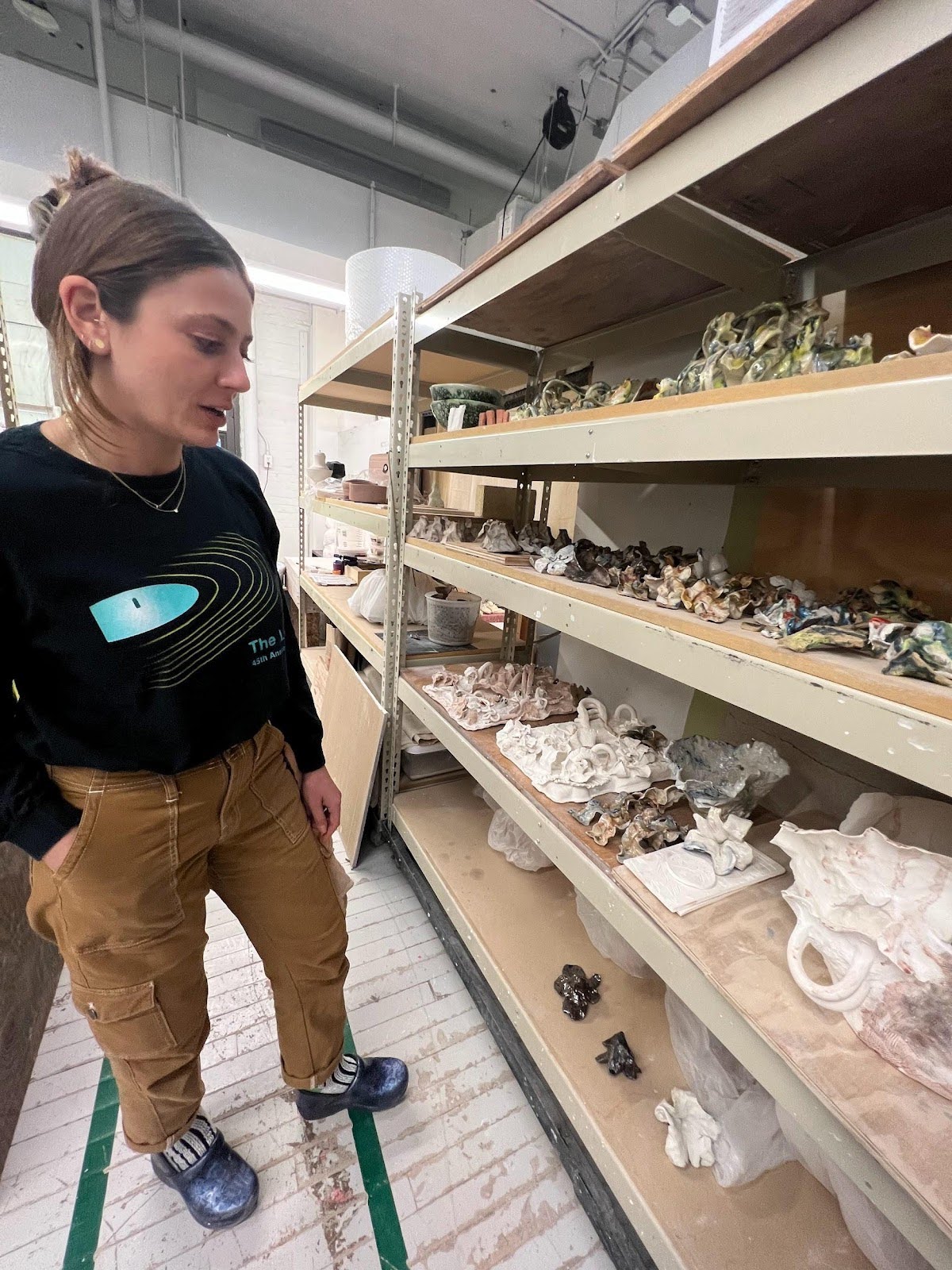Ana Popescu
Deanne Fernandes
→MFA ILL 2024
Ana Popescu
→ MFA CER 2025

Ana’s first experiment at RISD, titled Trash Monster.
I rushed to Ana’s studio, my hands freezing cold. Glancing at the temperature I contemplated whether this winter would be brutal, as the previous year was relatively mild. Winding my way through, a warm smile greeted me. The studio immediately felt cozy and inviting. The enticing aroma of masala chai and a plate of delightful treats elegantly arranged on Ana’s handcrafted ceramic pieces gave my freezing hands a warm hug. My mind did a little dance as I thought to myself, “This is going to be a good story session.” You can never go wrong in conversation over a cup of tea. We laughed as the mug had multiple handles as Ana explained to me how she likes non-functional pieces that challenge conventional notions of utility. This penchant for complicated pieces, she explained, was woven into her artistic practice, drawing inspiration from various narratives, including her journey to the United States.
When I asked Ana to give me a five minute sales pitch of her work and her art we both burst out laughing. Especially for a grad student, we exchanged a knowing look and acknowledged the futility of such an endeavor. “So can I start from the beginning?” Ana asked me, as I nodded, eager to hear where it all began.

Ana crafted a multi-handled mug to challenge the conventional notion of utility.
Born in Romania during a time of revolutionary upheaval, Ana migrated with her family to Miami, Florida, when she was three years old. The clash of two disparate worlds confronted her: one steeped in ancestral heritage with roots in communism, and the other, a new world embracing capitalist traditions. The challenge of navigating these opposing spheres became apparent, leading to a childhood marked by a sense of not fully belonging. Romanian traditions adorned her family home, creating a stark contrast with the American environment she found herself in. Despite the confusion, Ana’s summers spent in Romania provided a grounding connection to her country of birth.
Ana’s ceramic journey is like a fun adventure map commencing at Pratt Institute. Her undergraduate studies in sculpture evolved into installations crafted from found objects, incorporating textiles, ceramics, and even performance. Drawing inspiration from artists like Matthew Barney and Paul McCarthy, Ana created spaces that elicited an out-of-body experience for viewers, rooted in her early immigrant narrative. This artistic journey extended into the public realm through an underground art collective in NYC, founded by Ana herself. The collective became a space where her unique perspective on identity and transition resonated, creating a platform for dialogue and understanding.
Inspired by the NYC nightlife of the 1970s and ’80s, Ana would transform the spaces from floor-to-ceiling with different set designs and props that could inflate, deflate, and be moved around. She continued to grow her production career from there, leading large-scale high-profile branded productions across the US for various prominent advertising agencies in NYC.
The 2020 global pandemic changed the way Ana worked. As public spaces and events shut down, Ana’s practice became intimate and personal as she tried to craft moments and time through her mixed media pieces, which she referred to as “memory time capsules.” She began to repurpose old installations into collaged paintings and objects, incorporating elements of resin and tufting. The origin of her ceramic practice can be traced to this moment as she wanted to expand her material vocabulary and recreate the surface plasticity and glossy tension of resin. Ana joined a community studio called BKLYN Clay to learn ceramics in 2021, which makes her laugh now, as her ceramic studio practice is relatively new.
We both agreed that the narrative and inspiration behind her ceramics were a long time in the making. During her study at Arrowmont School of Arts and Crafts in Tennessee, she realized the presence of a wonderful craft community. It promoted the exchange of knowledge and resources. However, despite this accessibility, she felt a need to freely experiment and play. That is how she landed at RISD, even though the transition from nearly a decade of professional work to learning was quite intimidating.
Ana states that if she had to explain ceramics in one sentence it would be “being at peace with what you can’t control.” Ana questions the whole realm of craft versus fine arts and how she integrates the two worlds. Ceramics as a medium has helped her slow down after the hustle of New York. So how has the hustle of New York helped her navigate the student world? It has instilled in her the production mindset and the administration side of work. She can plan and schedule her work better and ultimately reach a stage of work-life balance. At RISD, she hopes to reach a flow state in her making practice, a state of uninhibited learning and discovery as she learns of new ways in which ceramics can be made and new spaces in which the medium can exist that transcend its traditional boundaries. Her current piece began when she cast the top of an industrial bin, bridging polar opposites by bringing the industrial into an organic space. She calls her first failure at RISD a “Trash Monster.’’ It was one of her first pieces to develop a crack as she built it. She hopes to fill in the cracks with new materials and transform the piece from a failure into a living object affected by time and memory. In a similar way, Ana has built a life by integrating her varied experiences across two cultures and is now proudly casting her way through RISD.
Follow Ana on instagram @a_pop.

Ana Popescu is a multi-disciplinary artist inspired by underlying meanings and concealed truths. Her harshest critic is her 6 lb chihuahua, Oskar Schlemmer :).
Deanne Fernandes is a visual storyteller and writer.